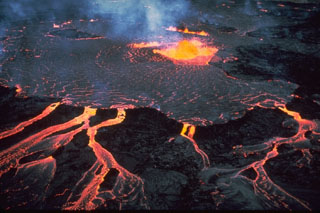Report on Kilauea (United States) — 26 March-1 April 2025
Smithsonian Institution / US Geological Survey
Weekly Volcanic Activity Report, 26 March-1 April 2025
Managing Editor: Sally Sennert.
Please cite this report as:
Global Volcanism Program, 2025. Report on Kilauea (United States) (Sennert, S, ed.). Weekly Volcanic Activity Report, 26 March-1 April 2025. Smithsonian Institution and US Geological Survey.
Kilauea
United States
19.421°N, 155.287°W; summit elev. 1222 m
All times are local (unless otherwise noted)
The Hawaiian Volcano Observatory (HVO) reported that the eruption within Kilauea’s Kaluapele summit caldera, from vents along the SW margin of Halema’uma’u Crater, continued at variable levels during 25 March-1 April. After a few days of no lava effusion from the N and S vents, activity resumed on 25 March. Eight cycles of rising lava in the N vent and small spatter fountaining were recorded during 0927-1155, with each cycle lasting 5-10 minutes and ending with lava draining back into the vent. At 1204 a more dynamic cycle began at the N vent with vigorous dome fountaining 10-20 m high and overflows of lava that extended onto the crater floor. Intermittent activity at the S vent also sent lava onto the crater floor. The cycles at the N vent continued through the day and by 0936 on 26 March nearly 100 cycles had been counted. Lava covered about 20 percent of the crater floor.
The cycles began to transition to lava fountaining at 1000 on 26 March, and by 1020 both vents were producing sustained fountains that rose more than 180 m. By 1045 fountains at the S vent were rising 180-210 m while N vent fountains were rising about half as high. Fountains at the S vent rose as high as 305 m during 1100-1200 and again at around 1330. Just after 1330 the S vent fountain began to incline, or bend over, with fountaining directed toward the SE. The inclined fountaining reappeared intermittently through the afternoon hours, with a maximum inclination approaching 45 degrees. By 1730 S vent fountains was vertical again with sustained heights of 150-215 m. Activity at the N vent ceased at around 1200 and fountaining at the S vent stopped at 1910. Lava flows covered 80-90 percent of the crater floor. Pele’s Hair and tephra was reported on surfaces in areas within Hawai’i Volcanoes National Park and surrounding communities. Sulfur dioxide gas emissions were estimated to be 50,000 tons per day during the periods of intense lava fountaining.
During 27-31 March spots of orange glow on the crater floor were visible at night, though diminished each day as the erupted lava cooled. Incandescent from the N vent was absent possibly due to being infilled with tephra and spatter from the S vent. A small opening in the S vent degassed and weakly glowed weakly during 27-28 March, was dark for a few nights, then was sporadically incandescent during 30-31 March.
Weak spattering began at the N vent at 1720 on 31 March. The spattering became continuous and by 1800 low lava fountains rose 5-10 m. The lava level in the vent gradually rose and overflowed at 2257, sending lava onto the crater floor. Incandescence from the S vent was visible overnight during 31 March-1 April and minor spattering was first observed by field crews at 0830 on 1 April. By 0944 lava covered only five percent of the crater floor. Fountaining at the S vent began and rapidly increased, rising to over 70 m by 1040 and exceeding 215 m by 1050. Low dome fountaining and overflows continue from the N vent. The Volcano Alert Level remained at Watch (the third level on a four-level scale) and the Aviation Color Code remained at Orange (the third color on a four-color scale).
Geological Summary. Kilauea overlaps the E flank of the massive Mauna Loa shield volcano in the island of Hawaii. Eruptions are prominent in Polynesian legends; written documentation since 1820 records frequent summit and flank lava flow eruptions interspersed with periods of long-term lava lake activity at Halemaumau crater in the summit caldera until 1924. The 3 x 5 km caldera was formed in several stages about 1,500 years ago and during the 18th century; eruptions have also originated from the lengthy East and Southwest rift zones, which extend to the ocean in both directions. About 90% of the surface of the basaltic shield volcano is formed of lava flows less than about 1,100 years old; 70% of the surface is younger than 600 years. The long-term eruption from the East rift zone between 1983 and 2018 produced lava flows covering more than 100 km2, destroyed hundreds of houses, and added new coastline.
Source: US Geological Survey Hawaiian Volcano Observatory (HVO)

